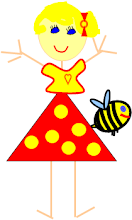I visited a two-year-old classroom on several occasions and observed that this was not a happy classroom. This was not a fun classroom. It was time to get these children singing and laughing.
I sat with the children on the floor and in a bright happy voice and introduced them to a cute little Hello Song that I use everyday when I am teaching my own class. The twos all just sat down and stared at me with big blank looks on their faces. We (the teachers and I) all laughed at their shock - it was the first time I heard any laughing from anyone in all my visits. So that was a start.
The key to getting children past the stage of shock or dislike of music is to keep singing the same songs over and over again. The more the children hear the song, the more familiar it becomes to them and to you.
It has been said that when introducing a new song, you should sing it at least four times in a row before the children will start to like it and sing along with you.
Don't give up on a new song that you have learned. Your enthusiasm will rub off and the children will start to love what you love. Sing the song often, add hand motions or other movements. As you sing the song often, you will make it your own and it will bring joy into your classroom.
Did you know music is like magic?
Want to hear some fingerplays and songs - click here!
Be sure and Follow My Blog to learn more about early childhood education.
Copyright © 2009 Deborah J. Stewart, All Rights Reserved!
The Latest on Teach Preschool!
Monday, April 20, 2009
Music Takes Committment
Saturday, April 18, 2009
Music is like Magic
In early childhood work, music takes on a magical quality. Music can magically change the experience and atmosphere of your classroom.
If you are thinking, "I can't sing and I don't know any songs so music just isn't for me." Let me encourage you to think again. It isn't how many songs you currently know or how well you sing that creates the magic - it is knowing just a few great tunes and having fun singing them with whatever type of voice you may or may not think you have.
If singing is new to you, it may feel awkward at first but as the children hear you having fun singing or dancing to a familiar tune, they will want to join in on your fun.
Teachers can use music in the classroom for many purposes:
- To capture student's attention
- To create a positive and nurturing environment
- To engage children in the learning process
- To give guidance and instruction
- To enhance self-esteem and confidence
Next time you want everyone to look at you, instead of raising your voice - try singing a catchy tune until everyone is either singing with you or at least looking your way. Get quieter as you sing and then tell your young students what you need.
Keep up to day with this blog - be sure to Follow My Blog!
What is a fingerplay?
Listen and learn music and fingerplays.
Copyright © 2009 Deborah J. Stewart, All Rights Reserved!
Friday, April 17, 2009
Fingerplays Take Practice
Use fingerplays effectively ...
I once observed a teacher who effectively started a fingerplay and all the children joined in. At the end of the fingerplay, the child became very quiet. The teacher immediately responded with a loud "SEE HOW QUIET YOU ALL CAN BE!" Well they weren't quiet anymore.
Use fingerplays to quiet the children and capture their attention. When it is working, don’t stop! Move right on into the next activity.
Why practice fingerplays?
- To be the most effective, fingerplays must be fun and engaging.
- To be fun and engaging, teachers must know the material well.
- Don't wait until you sit in front of the class to start learning a new fingerplay.
Keep up and Follow My Blog
What is a Daily Lesson Play?
Copyright © 2009 Deborah J. Stewart, All Rights Reserved!
Thursday, April 16, 2009
What is a Fingerplay?
It is a must that every early childhood educator spends time learning and memorizing a wide variety of fingerplays.
What is the purpose of a fingerplay?
Fingerplays serve a variety of purposes...
• They help capture a young child's attention;
• They engage the child in the learning process;
• They promote the young child's imagination and creativity;
• They increase a young child's language, vocabulary, and listening skills;
• They involve and promote the development of fine motor skills;
• They help the teacher give directions and instruction.
• They provide entertainment for down time.
An example of a fingerplay
Be Sure and Follow My Blog!
Listen and Learn New Fingerplays - click here.
What are children learning through play? - click here.
(This fingerplay has an Unknown Author)
Copyright © 2009 Deborah J. Stewart, All Rights Reserved!
Wecome Message
I have a Master's Degree in Early Chilhood Education and over 20 years experience in the field of early childhood education. The older I get the more I value and recognize the needs of young children and the important role the preschool teacher has in their lives. I hope to build, motivate, train, and promote excellence on behalf of our youngest learners. I hope you will join me.
To begin, this blog will be updated every Monday and we will see where it should go from there.
Deborah

